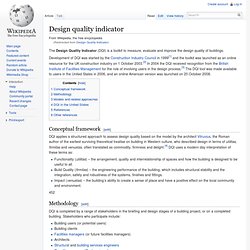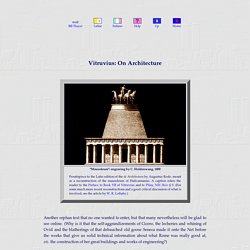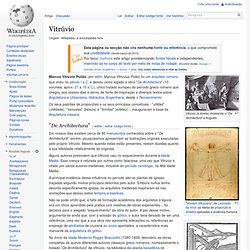

Design Quality Indicator. The Design Quality Indicator (DQI) is a toolkit to measure, evaluate and improve the design quality of buildings.

Development of DQI was started by the Construction Industry Council in 1999[1] and the toolkit was launched as an online resource for the UK construction industry on 1 October 2003.[2] In 2004 the DQI received recognition from the British Institute of Facilities Management for the role of involving users in the design process.[3] The DQI tool was made available to users in the United States in 2006, and an online American version was launched on 20 October 2008. Conceptual framework[edit] DQI applies a structured approach to assess design quality based on the model by the architect Vitruvius, the Roman author of the earliest surviving theoretical treatise on building in Western culture, who described design in terms of utilitas, firmitas and venustas, often translated as commodity, firmness and delight.[4] DQI uses a modern day interpretation of these terms as: References[edit]
Vitruvius. Marcus Vitruvius Pollio (born c. 80–70 BC, died after c. 15 BC), commonly known as Vitruvius, was a Roman author, architect, and civil engineer during the 1st century BC, known for his multi-volume work entitled De Architectura.

By his own description[1] Vitruvius served as an artilleryman, the third class of arms in the military offices. He probably served as a senior officer of artillery in charge of doctores ballistarum (artillery experts) and libratores who actually operated the machines.[2] Life and career[edit] Vitruvian Man by Leonardo da Vinci, an illustration of the human body inscribed in the circle and the square derived from a passage about geometry and human proportions in Vitruvius' writings Little is known about Vitruvius' life.
That [name is] very common in Formiae and regions adjacent, as well Dr. The locations where he served can be reconstructed from, for example, descriptions of the building methods of various "foreign tribes". Greek house plan after Vitruvius. Vitruvius de Arquitetura. Another orphan text that no one wanted to enter, but that many nevertheless will be glad to see online.

(Why is it that the self-aggrandizements of Cicero, the lecheries and whining of Ovid and the blatherings of that debauched old goose Seneca made it onto the Net before the works that give us solid technical information about what Rome was really good at, viz. the construction of her great buildings and works of engineering?) As almost always, I retyped the text rather than scanning it: not only to minimize errors prior to proofreading, but as an opportunity for me to become intimately familiar with the work, an exercise which I heartily recommend. (Well-meaning attempts to get me to scan text, if successful, would merely turn me into some kind of machine: gambit declined.)
Anyway, the text has been thoroughly proofread, and I believe it to be free of errors (but if there are errors, please report them). Background Material Text and Translations Chapter and Section Numbering, Headings. Vitrúvio. Origem: Wikipédia, a enciclopédia livre.

Vitrúvio (à direita) mostrando o "De Architectura" a Augusto. Ilustração de um mecanismo para captação de água para a obra "De Architectura". Marcos Vitrúvio Polião (em latim, Marcus Vitruvius Pollio) foi um arquiteto romano que viveu no século I a.C. e deixou como legado a obra "De Architectura" (10 volumes, aprox. 27 a 16 a.C.), único tratado europeu do período greco-romano que chegou aos nossos dias e serviu de fonte de inspiração a diversos textos sobre Arquitetura e Urbanismo, Hidráulica, Engenharia, desde o Renascimento.
Os seus padrões de proporções e os seus princípios conceituais - "utilitas" (utilidade), "venustas" (beleza) e "firmitas" (solidez) -, inauguraram a base da Arquitetura clássica. "De Architectura"[editar | editar código-fonte] Em nossos dias existem cerca de 80 manuscritos conhecidos sobre o "De Architectura", porém, pouquíssimos apresentam as ilustrações originais executadas pelo próprio Vitrúvio.